-
Explain the Naming of Transistor Terminals
(Solved)
Explain the Naming of Transistor Terminals
Date posted:
August 14, 2019
.
Answers (1)
-
Over what range of input voltage will the Zener circuit shown in Fig. 3.68 maintain 30 V across 2000 O load, assuming that series resistance...
(Solved)
Over what range of input voltage will the Zener circuit shown in Fig. 3.68 maintain 30 V across 2000 Ω load, assuming that series resistance R = 200 Ω and Zener current rating is 25 mA ?
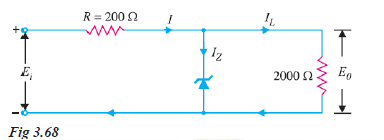
Date posted:
August 14, 2019
.
Answers (1)
-
What value of series resistance is required when three 10-watt, 10-volt, 1000 mA Zener diodes are connected in series to obtain a 30-volt regulated output...
(Solved)
What value of series resistance is required when three 10-watt, 10-volt, 1000 mA Zener diodes are connected in series to obtain a 30-volt regulated output from a 45 volt d.c. power source ?
Date posted:
August 14, 2019
.
Answers (1)
-
The circuit of Fig. 3.66 uses two Zener diodes, each rated at 15 V, 200 mA.
(Solved)
The circuit of Fig. 3.66 uses two Zener diodes, each rated at 15 V, 200 mA. If the circuit is connected to a 45-volt unregulated supply, determine:
(i) The regulated output voltage
(ii) The value of series resistance R
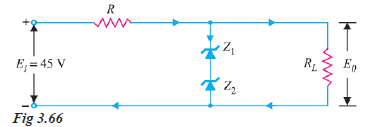
Date posted:
August 14, 2019
.
Answers (1)
-
A 10-V Zener diode is used to regulate the voltage across a variable load resistor [See fig. 3.65].
(Solved)
A 10-V Zener diode is used to regulate the voltage across a variable load resistor [See fig. 3.65]. The input voltage varies between 13 V and 16 V and the load current varies between 10 mA and 85 mA. The minimum Zener current is 15 mA. Calculate the value of series resistance R.

Date posted:
August 14, 2019
.
Answers (1)
-
The Zener diode shown in Fig. 3.64 has VZ = 18 V.
(Solved)
The Zener diode shown in Fig. 3.64 has VZ = 18 V. The voltage across the load stays at 18 V as long as IZ is maintained between 200 mA and 2 A. Find the value of series resistance R so that E0 remains 18 V while input voltage Ei is free to vary between 22 V to 28V.

Date posted:
August 14, 2019
.
Answers (1)
-
A 7.2 V Zener is used in the circuit shown in Fig. 3.63 and the load current is to vary from 12 to 100 mA.
(Solved)
A 7.2 V Zener is used in the circuit shown in Fig. 3.63 and the load current is to vary from 12 to 100 mA. Find the value of series resistance R to maintain a voltage of 7.2 V across the load. The input voltage is constant at 12V and the minimum Zener current is 10 mA.

Date posted:
August 14, 2019
.
Answers (1)
-
For the circuit shown in Fig. 3.62 (i), find the maximum and minimum values of Zener diode current.
(Solved)
For the circuit shown in Fig. 3.62 (i), find the maximum and minimum values of Zener diode current.

Date posted:
August 14, 2019
.
Answers (1)
-
For the circuit shown in Fig. 3.61 (i), find:
(Solved)
For the circuit shown in Fig. 3.61 (i), find:
(i) the output voltage
(ii) the voltage drop across series resistance
(iii) the current through Zener diode.

Date posted:
August 14, 2019
.
Answers (1)
-
Explain Zener Diode as Voltage Stabilizer
(Solved)
Explain Zener Diode as Voltage Stabilizer
Date posted:
August 14, 2019
.
Answers (1)
-
What is a Zener Diode?
(Solved)
What is a Zener Diode?
Date posted:
August 14, 2019
.
Answers (1)
-
Define the following terms:
(Solved)
Define the following terms:
(i) Forward current
(ii) Peak inverse voltage
(iii) Reverse current or leakage current
Date posted:
August 14, 2019
.
Answers (1)
-
Determine the state of diode for the circuit shown in Fig. 3.18 (i) and find ID and VD. Assume simplified model for the diode.
(Solved)
Determine the state of diode for the circuit shown in Fig. 3.18 (i) and find ID and VD. Assume simplified model for the diode.

Date posted:
August 14, 2019
.
Answers (1)
-
Determine if the diode (ideal) in Fig. 3.17 (i) is forward biased or reverse biased.
(Solved)
Determine if the diode (ideal) in Fig. 3.17 (i) is forward biased or reverse biased.
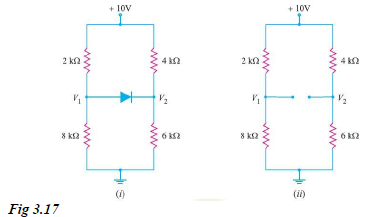
Date posted:
August 14, 2019
.
Answers (1)
-
Determine the currents I1, I2 and I3 for the network shown in Fig. 3.16
(Solved)
Determine the currents I1, I2 and I3 for the network shown in Fig. 3.16(i). Use simplified model for the diodes.
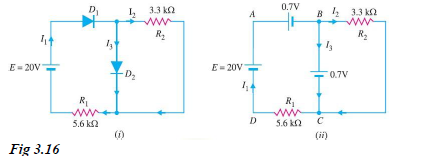
Date posted:
August 14, 2019
.
Answers (1)
-
Determine current through each diode in the circuit shown in Fig. 3.15
(Solved)
Determine current through each diode in the circuit shown in Fig. 3.15 (i). Use simplified model. Assume diodes to be similar.
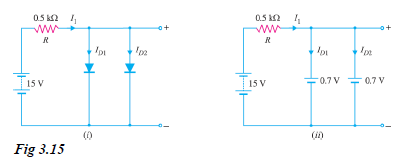
Date posted:
August 14, 2019
.
Answers (1)
-
Find VQ and ID in the network shown in Fig. 3.14 (i). Use simplified model
(Solved)
Find VQ and ID in the network shown in Fig. 3.14 (i). Use simplified model
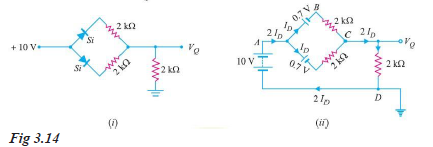
Date posted:
August 14, 2019
.
Answers (1)
-
Find the voltage VA in the circuit shown in Fig. 3.13 (i). Use simplified model.
(Solved)
Find the voltage VA in the circuit shown in Fig. 3.13 (i). Use simplified model.
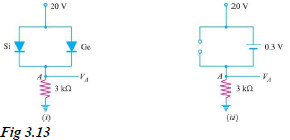
Date posted:
August 14, 2019
.
Answers (1)
-
Determine the current I in the circuit shown in Fig. 3.12
(Solved)
Determine the current I in the circuit shown in Fig. 3.12
(i). Assume the diodes to be of silicon and forward resistance of diodes to be zero.

Date posted:
August 14, 2019
.
Answers (1)
-
Calculate the current through 48 O resistor in the circuit shown in Fig. below
(Solved)
Calculate the current through 48 Ω resistor in the circuit shown in Fig. below
(i). Assume the diodes to be of silicon and forward resistance of each diode is 1 Ω.
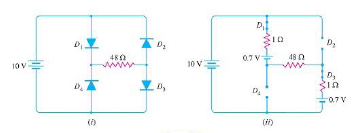
Date posted:
August 14, 2019
.
Answers (1)